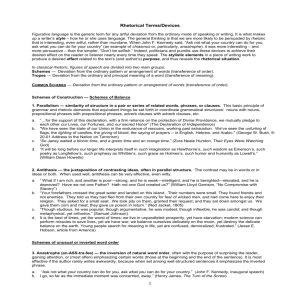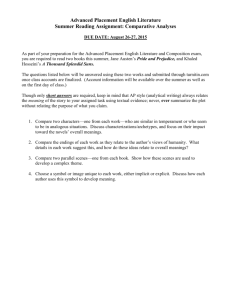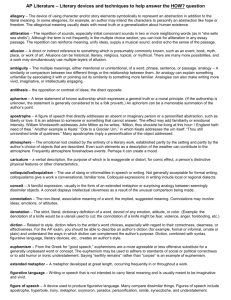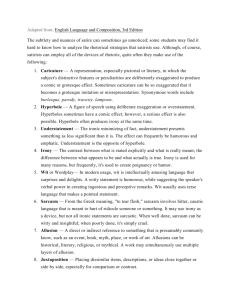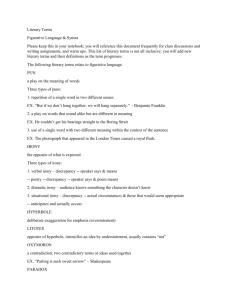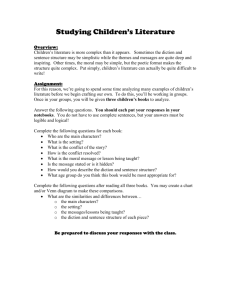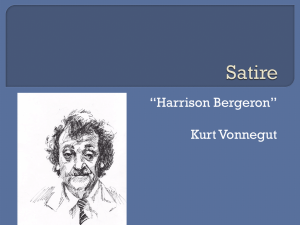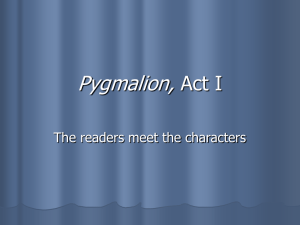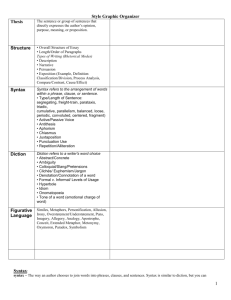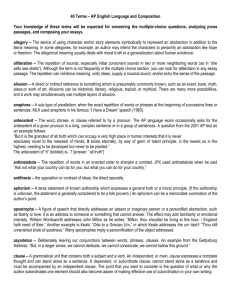Rhetorical Analysis Terms and Definitions
advertisement
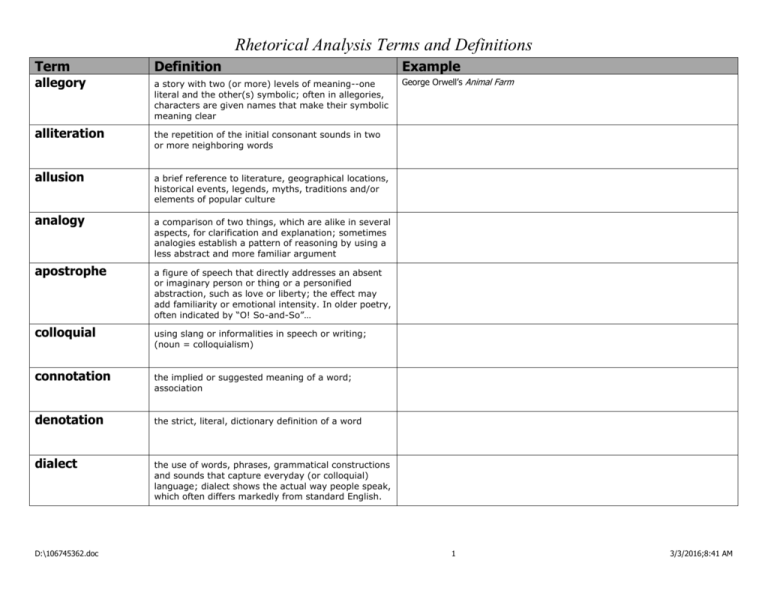
Rhetorical Analysis Terms and Definitions Term Definition Example allegory a story with two (or more) levels of meaning--one literal and the other(s) symbolic; often in allegories, characters are given names that make their symbolic meaning clear George Orwell’s Animal Farm alliteration the repetition of the initial consonant sounds in two or more neighboring words allusion a brief reference to literature, geographical locations, historical events, legends, myths, traditions and/or elements of popular culture analogy a comparison of two things, which are alike in several aspects, for clarification and explanation; sometimes analogies establish a pattern of reasoning by using a less abstract and more familiar argument apostrophe a figure of speech that directly addresses an absent or imaginary person or thing or a personified abstraction, such as love or liberty; the effect may add familiarity or emotional intensity. In older poetry, often indicated by “O! So-and-So”… colloquial using slang or informalities in speech or writing; (noun = colloquialism) connotation the implied or suggested meaning of a word; association denotation the strict, literal, dictionary definition of a word dialect the use of words, phrases, grammatical constructions and sounds that capture everyday (or colloquial) language; dialect shows the actual way people speak, which often differs markedly from standard English. D:\106745362.doc 1 3/3/2016;8:41 AM Term Definition diction word choice; diction must be “named,” i.e. described as specifically as possible. An author’s choice of diction contributes to the tone and mood of the piece. dysphemism a degenerative or less agreeable substitute for words or concepts; can often create a insult. euphemism a more agreeable or less offensive substitute for an unpleasant word or concept facetious language joking or jesting often inappropriately; meant to be humorous or funny: not serious homily a sermon or serious talk, speech or lecture involving moral or spiritual advice Consider MLK’s—“I Have a Dream” speech. Consider parental and religious homilies. hyperbole exaggeration for emphasis or humor imagery the use of language to describe and/or evoke sensory experience; Imagery must, like diction, be “named.” Pay attention to a writer’s diction and use of detail for hints about how to name the imagery. irony the contrast between what is expected and reality Example “boneyard,” instead of cemetery _____________ irony: Review: What are the three main types of irony? _____________ irony: _____________ irony: D:\106745362.doc 2 3/3/2016;8:41 AM Term Definition metaphor one thing is spoken of as though it were something else; through this identification of dissimilar things, a comparison is suggested or implied extended metaphor A metaphor which is drawn-out beyond the usual word or phrase to extend throughout a stanza, an entire poem, through or across paragraphs, usually by using multiple comparisons between the unlike objects or ideas. metonomy a figure of speech in which the name of one object is substituted for that of another object closely associated with it oxymoron a combination of contradictory words and meanings onomatopoeia words that imitate the natural sounds they name paradox a statement that appears to be self-contradictory or opposed to common sense but upon closer examination contains some degree of truth or validity parody a work (literature, music, film) that closely imitates the style or content of another work with the specific aim of comic effect and/or ridicule personification presenting or describing concepts, animals or inanimate objects by giving them human qualities point of view the perspective from which a story is told (or an essay is written): first person (I, we), second person (you), or third person (he, she, it, they). Also can mean the author’s position about the subject pun a play on words that are either identical in sound (homonyms) or similar in sound, but that are sharply different in meaning repetition words, phrases, actions, and ideas that appear over and over again; usually, repetition in good literature highlights a pattern or makes a point D:\106745362.doc Example 3 3/3/2016;8:41 AM Term Definition rhetoric the art of writing and speaking effectively and persuasively; refers to the choices an author or speaker makes in order to do so sarcasm biting, caustic language that is meant to hurt or ridicule someone or something satire a work (literature, music, film) that uses irony, wit, parody, caricature, hyperbole, understatement and sarcasm to target human vices and follies or social institutions and conventions for reform or ridicule shift a change in verb tense, location, speaker, narrative method, setting or tone simile a comparison between two things which are not alike, but which share at least one common element; similes explain an unfamiliar thing by comparing it to something familiar; similes use like, as, or similar explicit words to make the comparison style the sum of choices an author makes in blending diction, syntax, figurative language, and other literary and rhetorical devices symbolism objects and actions that stand for or represent something beyond their literal meaning syntax sentence construction. Some authors heavily use prepositional phrases, for example. Hemmingway uses prepositional phrases liberally in order to describe. Perhaps some sentences are written with a short and choppy cadence to parallel an intense action in the text. The sentence structure in this case would contribute to the text’s intensity. SCHEMES are also examples of syntax. text something written, performed or spoken considered as an object to be examined: movies, books, poetry, etc. are considered texts. theme the central idea or message of a text; the insight it offers; Theme is not typically stated directly. D:\106745362.doc Example Provide an example of a short passage with interesting or notable syntax: 4 3/3/2016;8:41 AM Term Definition thesis (also thesis statement) the sentence or group of sentences that directly express a writer’s opinion, purpose, idea or meaning tone the author’s attitude toward his or her subject and/or toward the audience litotes, aka understatement the minimalization of fact or presentation of something as less significant than it is; the opposite of hyperbole Example Alliteration – repetition of consonant sound in neighboring words Assonance – repetition of internal vowel sounds in neighboring words Euphemism – substituting inoffensive term for offensive one Hyperbole – extreme exaggeration Irony – meaning often contradicted by appearance of ideas Metaphor – comparison between two unlike things to show commonalities Onomatopoeia – use of words that imitate their associated sounds Oxymoron – contradictory terms appear side by side Personification – inanimate object or abstraction is given human like qualities Pun – a play on words Simile – comparison between two things using like or as Understatement. – deliberately making something more important than it is Anaphora – repetition of the same word/phrases at beginning of successive clauses or verses Antithesis – the juxtaposition of contrasting ideas in balanced phrases Apostrophe – breaking off discourse to address some absent person or thing Chiasmus – verbal pattern where second half of expression is balanced with the first part, but reversed Litotes – understatement where an affirmative is expressed by negating its opposite Metonymy – describing something indirectly by referring to the things around it. Paradox – a statement that appears to contradict itself Synecdoche - a part is used to represent the whole, the general represents the specific. < D:\106745362.doc 5 3/3/2016;8:41 AM
